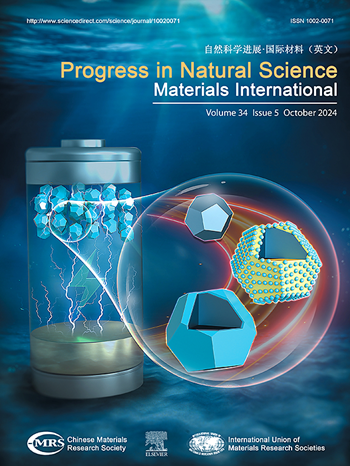High-pressure sintering of ultrafine-grained TiCN ceramics
IF 7.1
2区 材料科学
Q2 MATERIALS SCIENCE, MULTIDISCIPLINARY
Progress in Natural Science: Materials International
Pub Date : 2025-08-01
DOI:10.1016/j.pnsc.2025.06.006
引用次数: 0
Abstract
Ultrafine-grained TiCN ceramics exhibiting enhanced mechanical performance were successfully fabricated by high-pressure sintering technology. Systematic investigations were conducted to assess the impacts of sintering temperature on grain size, relative density, hardness, fracture toughness and flexural strength. The optimized samples, sintered at 6 GPa and 1400 °C, achieved near-theoretical density (99.2 ± 0.2 % relative density) while preserving an ultrafine-grained microstructure with an average grain size of 270 ± 36 nm. This microstructure demonstrated exceptional mechanical properties, exhibiting a synergistic enhancement in both Vickers hardness (22.6 ± 0.4 GPa) and fracture toughness (3.6 ± 0.2 MPa m1/2) compared with spark plasma sintered coarse-grained TiCN ceramics and high pressure sintered submicron-grained TiCN ceramics. Notably, ultrafine-grained TiCN ceramics retained a Vickers hardness of 12.5 ± 0.4 GPa at 800 °C, which is 38.8 % higher than that of submicron-grained TiCN ceramics. The superior mechanical performance is attributed to the synergistic effects of grain refinement-induced strengthening and microcrack deflection-assisted toughening mechanisms.
超细晶TiCN陶瓷的高压烧结
采用高压烧结技术成功制备了力学性能优异的超细晶TiCN陶瓷。系统研究了烧结温度对晶粒尺寸、相对密度、硬度、断裂韧性和抗弯强度的影响。优化后的样品在6gpa和1400℃下烧结,获得了接近理论的密度(99.2±0.2%的相对密度),同时保持了平均晶粒尺寸为270±36 nm的超细晶组织。与火花等离子烧结粗晶TiCN陶瓷和高压烧结亚微米晶TiCN陶瓷相比,该显微结构表现出优异的力学性能,在维氏硬度(22.6±0.4 GPa)和断裂韧性(3.6±0.2 MPa m1/2)方面均有协同增强。在800℃时,超细晶TiCN陶瓷的维氏硬度为12.5±0.4 GPa,比亚微米晶TiCN陶瓷的维氏硬度高38.8%。优异的力学性能是晶粒细化强化和微裂纹偏转辅助增韧机制协同作用的结果。
本文章由计算机程序翻译,如有差异,请以英文原文为准。
求助全文
约1分钟内获得全文
求助全文
来源期刊
CiteScore
8.60
自引率
2.10%
发文量
2812
审稿时长
49 days
期刊介绍:
Progress in Natural Science: Materials International provides scientists and engineers throughout the world with a central vehicle for the exchange and dissemination of basic theoretical studies and applied research of advanced materials. The emphasis is placed on original research, both analytical and experimental, which is of permanent interest to engineers and scientists, covering all aspects of new materials and technologies, such as, energy and environmental materials; advanced structural materials; advanced transportation materials, functional and electronic materials; nano-scale and amorphous materials; health and biological materials; materials modeling and simulation; materials characterization; and so on. The latest research achievements and innovative papers in basic theoretical studies and applied research of material science will be carefully selected and promptly reported. Thus, the aim of this Journal is to serve the global materials science and technology community with the latest research findings.
As a service to readers, an international bibliography of recent publications in advanced materials is published bimonthly.

 求助内容:
求助内容: 应助结果提醒方式:
应助结果提醒方式:


